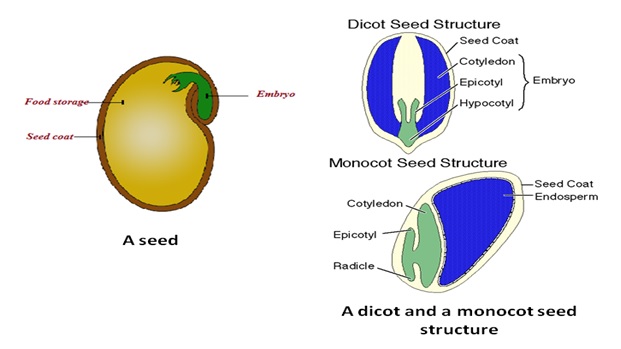Grow your Garden
Bringing your kids close to nature: Seed to plant and garden

Life starts with seed. Seed germination and growing plant can be fun filled activity for kids. This will bring them close to nature. While growing a garden they will observe other living beings that live in nature. Let kids understand the concept of nature and life while growing a plant from seed.
What is a seed?
A seed is an embryonic plant enclosed in a protective outer covering called the seed coat, usually with some stored food. Seeds are all around us, just waiting in the soil to grow. By gathering dirt from several areas, you can grow a garden and see what pops up from those secret seeds.
What are two common types of seeds and What is the structure of a seed?
The two types of seeds are Dicot and Monocot. A seed will have an embryo, a food storage part that feeds embryo and a protective seed coat.
Dicots with two cotyledons and monocot with one cotyledon. Cotyledon is nothing but seed leaf. Upon germination they become first leaves of a plant.
Apart from cotyledons during germination one can see following parts in seed:
Epicotyl: A portion above the cotyledon that ends in shoot apex
Hypocotyl: A portion below the first leaves
Radical: That leads to root apex
Root apex: Tip of growing root
Shoot apex: Tip of growing shoot

How do we germinate a seeds?
Germination is fun. To make it more fun and to see how different seeds behave in the soil you can use varieties of seeds (say bean, mustard and wheat). Germination procedure that you follow for monocot and dicot seeds varies.
What you need for germination of seeds?
a) dirt or soil
b) spoon or scoop
c) pots or a garden bed
d) water
e) label
f) Seeds of bean, mustard and wheat
Step 1: Collect seeds
Step 2: Take 3 pots or a place in the garden which can be divided into 3 small planting sections
Step 3: Label each pot or section with the name of the plant: Beans, Mustard and Wheat.
Step 4: Sprinkle little water over the soil in each section or in pots.
Step 5: For beans: Take a small stick and make one inch -five holes in the pot. Place five seeds in each hole and cover with soil. Sprinkle water on the surface. Water your garden well, moistening the soil to a depth of 3 to 4 inches. Keep soil evenly moist until the bean seeds germinate, which typically occurs within two weeks.
For mustard: On the surface of soil sprinkle 20 seeds and sprinkle water. Keep the soil moisturized by sprinkling water every day.
For Wheat: Follow these steps: Wheat is monocot and it needs prior sprouting where you see root coming out of seed before planting to ensure the seed germinates properly
a) Soak the wheat for about 8-10 hours and drain the water.
b) After 10 hours check whether you can seed sprouted roots which is at least 1/8 to 1/4 inch.
c) Place the sprouted seeds on the soil surface either in a pot or on garden bed or in a tray.
d) Take a plastic clear wrapper sheet and gently place it on the surface of sprouted wheat seeds.
e) check every day or two for signs of any plants sp from secret seeds.
Observations:
Compare the plants that you raised to following diagrams and identify them. Also observe following developmental stages in the plant.
Reference : http://i.imgur.com/AyopY2J.gif

Note down:
a) when the cotyledons comes out.
b) how long is the shoot and root.
c) how many days it takes for all seeds to germinate
d) did all seeds germinate?
e) when did the flower bud appeared?
f) what is the color of flower?
g) are there any insect visitors for the plants?
h) did the plants set fruits and seeds?
i) how does the leaf look like -what shape it has?
j) how a fruit looks like and what is its color and shape?
k) how many seeds are in the fruit?
l) plant the dry seeds again and see whether you can grow second generation? Similarly grow various types of vegetables and flowering plants using seeds, cuttings and other propagation methods.

